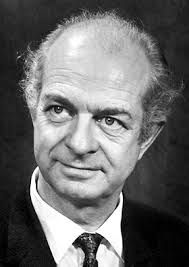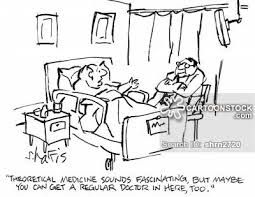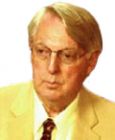
Introduction:
What follows is an autobiographical account of my involvement with medicine as a practicing psychologist on Manhattan's Upper East Side, and Senior Staff Psychologist at the Outpatient Clinic of a VA Hospital until my recent retirement. This, and having previously earned advanced degrees in both biology and psychology, has given me a unique perspective on medicine I'd like to share with you. I'm especially interested in what I've always called "theoretical medicine." It is a field of study that has become far more fashionable than when I began thinking about it in my college days. I hope you find "my story" interesting and informative.
In a previous blog I shared my experience as a doctoral student which influenced my thinking about medicine and psychology. After graduating UT Austin, I joined the faculty of Long Island University which was engaged in the building of a new doctoral psychology program under Chairman G. M. Gilbert. Chairman Gilbert was formerly Chief Psychologist at the Nuremberg Trials following World War II, and author of Psychology of Dictatorship and Nuremberg Diary in which he records his interviews and consultations with the Nazis on trial for "crimes against humanity." My conversations with him contributed to my interest in the study of values at a time when some regarded the concept of "value" as obsolete in the field of psychology.
From College Professor to Practicing Doctor:
There came a weekend when fate had me riding horses in Central Park with Professor Benjamin Wolman, a senior faculty member, author, editor, and psychoanalyst. It was then we began a collaboration resulting in the publication of our Handbook of General Psychology published by Prentice-Hall.

Whatever ability I possessed as an editor I owe to Wolman. Whatever skills I had riding horses I acquired riding Quarter Horses in Texas with dates who thought this was a cool thing to do. What followed in quick succession was my completion of a postdoctoral internship, the building of a private practice, and becoming a Senior Staff Psychologist in the Outpatient Clinic at the VA Hospital.
International Academy of Preventive Medicine (IAPM)
Durng my early academic years, I met Dr. Carlton Fredericks, host of the popular Design for Living broadcast over WOR radio into the homes of millions in the Tri-State region of N.Y., N.J., and CT., thanks to its 50,000 Watt transmitter. Carlton was an articulate author, lecturer, consulting nutritionist, and friend of physicians with an interest in nutrition which wasn’t all that common among M.D.s at the time; although osteopathic, homeopathic, and naturopathic practitioners had long held an interest in alternatives to mainstream medicine. At the time, Carlton’s views and critical reviews alienated some local medical societies and regulatory agencies, often in the pocket of what he called the "pharmaceutical-industrial complex."
Carlton’s one-man-media-show was sustained by a growing populist interest in nutrition, medical innovation, medical alternatives, and freedom-of-choice where doctors and treatments were concerned. He was also an admirer of my Texas mentor Williams who gave him a scientific foundation for broadcasting tomorrow’s preventive medicine today. Carlton’s views and information were increasingly embraced by a growing number of physicians who were familiar with my mentor’s contributions.
I wanted to meet Dr. Fredericks and so I invited him to address my graduate students. He discussed Psychonutrition. This was probably the first time psychology majors had ever been exposed to these ideas. They were impressed, but some of my colleagues, more concerned about the accreditation of our doctoral program by the American Psychological Association (APA), were less impressed. Psychonutrition wasn’t viewed as compatible with psychological interests.
__________
It was a sunny September morning when I received a follow-up call from Carlton asking if I could meet him for lunch at the Algonquin Hotel later that week. He spoke of a group of physicians interested in creating a medical society willing to explore clinical nutrition and medical alternatives in general. They wanted to learn more about the clinical implications of biochemical individuality and ways of integrating the treatment of causes with the treatment of symptoms. The doctors also sought the protection of membership in a professional society at a time when peers, local medical societies, and regulatory agencies were giving them problems.
Carlton had shared my background and connections with the doctors who then suggested he invite me to join their organizational meeting planned for Vail, Colorado that winter. Once assured my expenses would be covered, I agreed. I then discovered that physicians were coming from Texas, Colorado, Michigan, California, and New York, and that a Houston physician with deep pockets by the name of Dr. R. O. Brennan was covering start-up costs. Carlton assumed Brennan was an admirer of Williams although they had never met.
____________
Attending the Vail Conference put me in the inner circle of doctors involved with making arrangements and all the planning. At some point, between rides on snowmobiles (i.e., not horses this time) and conferencing, Dr. Robert McCullough, former President of Lions International, asked if I would be willing to personally invite Professor Williams and Linus Pauling to attend our St. Louis conference (Below: Photo of Linus Pauling).

I agreed and went on to be successful in getting them to attend our meeting at our expense. It was at that meeting we gave birth to a new medical society for doctors reflecting the paradigm shift taking place in medicine. We called ourselves the International Academy of Preventive Medicine (IAPM).
We elected Dr. Robert McCullough our first president. I was asked to serve on the governing board and as founding Editor-in-Chief of publications which would include the Quarterly Journal, the JIAPM, and multivolume New Dynamics of Preventive Medicine series. Carlton must have told them about my experience editing The Handbook of General Psychology. Ironically, it wasn’t long after that my clinical mentor, Albert Ellis, asked me to edit his psychology journal. I had to decline given the JIAPM commitment.
__________
The topics that came before our meetings were far ranging in scope and included the question of Food Allergies (e.g., Gluten Sensitivities) long before they were understood and treated by conventional medicine. I bring it up because it’s an example of how far we have come and how much we were ahead of the times. Today Gluten Free Bakeries are commonplace. The isles of food stores are lined with Gluten Free Products. I published articles on the subject when no one else did. This is not the place for me to itemize all our insights and prescience, but it’s worth noting that we pioneered the field we called “Clinical Ecology,” having to do with our response to allergens and environmental pollution which upsets our immune systems. I recall how some physicians refused to attend meetings in new hotels because of the outgassing of volatile petrochemicals from curtains, upholstery, and carpets reflecting their awareness of toxic environmental chemicals or experience treating patients with such issues.

In time we began offering educational programs for the general public, and with Carlton’s radio programs, we stimulated a mass, bottom-up-revolution much stronger than the doctor driven top-down-revolution in the field of medicine. As a result, New York State passed legislation protecting a patient’s right to freedom-of-choice, and the Congress passed (i.e., our doctors testiified before congress) legislation establishing the Preventive Medicine Division of the National Institute of Health (NIH).
__________
And so this “apple didn’t fall far from the tree.” I hadn’t forgotten or abandoned my Texas experience and this allowed me to look after the health and wellbeing of patients like no other psychologist in Manhattan. In private practice I was free to do this. At the hospital I had to be more considerate of the educational backgrounds of physicians and psychiatrists with whom I worked. In the meantime the IAPM grew to over 1,000 doctors from around the world. I covered my editorial responsibilities with ease given the help of a newly hired Executive Director. This freed me to begin exploring a new frontier related to health care. It involved collaboration with philosophers interested in the scientific study of values which both G. M. Gilbert and Albert Ellis had encouraged me to think about. I’ve shared this experience in previous Blogs, and will continue to do so in future Blogs.
__________
During my IAPM years, I met many dedicated physicians from all over the world. I especially remember two. There was the enthusiasm of Dr. Hans Nieper (1928-1998) pioneering new cancer, alcoholism, and multiple sclerosis treatments. He advanced our understanding of supplements called “mineral transporters.” Hans took his medical degree at the University of Hamburg and served as director of the Department of Medicine at Silbersee Hospital in Hanover. Then there was the physician from Australia whose amazing story I will now share with you.
__________
Vaccination and Immunization Reconsidered:


As editor of the Quarterly JIAPM, I solicited and selected articles for publication. I made some controversial calls, but with my editorial board behind me. Perhaps one of my more controversial decisions was to publish an article by Archie Kalokerinos, M.D.
Archie graduated from Sydney University Medical School. He then practiced medicine in England before returning to Australia to serve as Medical Superintendent of Collarenebri Hospital. His hobby was prospecting for opals at Coober Pedy which is a region of some 70 gem quality opal fields. When Archie learned of the high mortality rates (i.e., half the vaccinated children died) among Aboriginal children, following routine vaccinations, he became concerned and involved.
Knowing something about how Aboriginal children live, Archie suspected malnutrition made Western vaccinations unsafe. He determined the cause was Vitamin C deficiencies at the time of vaccination that killed half the children. He gave the children Vitamin C before and after vaccination. He was successful and none died.
Archie’s book Every Second Child tells the story. It was banned by many “authorities” in Australia and England; but it ended up as a movie. The book was finally published in paperback by Keats Publishing (1981) in the U.S. Linus Pauling wrote in the preface: “Dr. .Kalokerinos deserves much credit for making these discoveries." He believed safe vaccinations require adequate levels of Vitamin C to be safe.
The Rest of the Story:
One day Archie and his friend Glenn, both members of IAPM, visited me in Manhattan. I met them for diner at the Taft Hotel off Time’s Square. There we talked about his interests and hobby of prospecting for opals. He would become the world’s leading authority on Australian opals following the publication of his In Search of Opal and The Australian Precious Opal. After diner, Archie surprised me when he reached into his pocket and gave me two spectacular “Fire Opals” in honor my work with IAPM. I had the opals mounted on 24 K Indonesian gold rings during one of my many trips to Bali (Below: Photo of the Fire Opal).

___________
Cell Therapy:
Many years ago I recall an IAPM physician told me he had travelled to Switzerland for “cell therapy;” not to be confused with today’s “stem cell therapy;” although it surely foreshadowed today’s “stem cell therapy.” It involved the intramuscular injection of prepared animal fetal tissue. I was told at the time that radioactive tracer studies in animals revealed how the injected fetal cells found their way to the organs where needed in a manner suggesting communication among cells of the body. A weak thyroid might suggest the injection of fetal thyroid cells. Diabetes might suggest the injection of fetal pancreatic cells. Cancer might suggest the injection of thymus cells or bone marrow cells, and so forth. It isn't out of the question that he may have been looking to increase sexual energy, or was looking for the proverbial Fountain of Youth pursued by the Spanish conquistador Juan Ponce de León (1474 - 1521).
The “cell therapy” was real, it was controversial, it was pursued by many long before “stem cell therapy” which became a source of controversy triggering ethical and legal concerns in the United States that resulted in prohibition by the Reagan and Bush administrations, and then lifted by the Clinton administration.
The Rest of the Story:
Over diner recently at the Renaissance Hotel here in Washington, D.C. a young physician member of our family, following procedures developed in Germany, reported the successful use of human stem cells with patients which included mother (i.e., acute asthma) and husband (i.e., acute back pain). What does that tell you? With hindsight, it appears our IAPM physician was on to something years ago. It tells us we’re onto something today; although this treatment remains unavailable in the United States pending the usual controlled, double-blind studies establishing statistical efficacy and statistical safety.
Big Question:
Where did "our doctor" get the human stem cells? It will surprise you to know that they were obtained from the patient’s own adipose (i.e., fatty) tissue. The stem cells were extracted from the patient’s own body fat, prepared, and returned to the same patient by IV injections. There is hope that stem cells may one day treat Dementia, Parkinson and Alzheimer diseases.
Must we commit so slavishly to controlled, double blind studies? What about clinical experience? What about longitudinal N = 1 studies (i.e., explored by my former colleague Dr. Donald Davis)? Perhaps we we need to push the development of a theoretical medicine analogous to theoretical physics?

"Theoretical medicine sounds fascinating, but maybe you can get a regular doctor in here too."
Economic Considerations:
You’re not going to believe this! Maybe you will...given the rising tide of cynicism following the Great Recession of 2008, and the wave of social unrest (e.g. polarization of governance), and unemployment that followed. Our government’s effective monetary policies (i.e., Federal Reserve Driven) in the face of a poor fiscal response (i.e., Legislative Neglect) to the Great Recession slowed recovery. Not enough capital was thrown at capitalism when absolutely needed. Ignoring our experience until more recently, Europeans are now learning the same lesson. Economics isn't a scientific discipline and so economists are left fighting with each other at the level of ideologies. I suspect that a science of values is the missing link in the field of economics..
Let’s consider how the Wall Street Casino hinders and damages the development of biological medicine. In the Sunday, September 28th edition of The Washington Post Steven Pearlstein writes that strategic Short Selling on Wall Street (i.e., betting the stock of a company will go down) has recently interfered with the development of immunotherapy by Northwest Biotherapeutics of Bethesda. He writes this company is seeking to market a vaccine treatment for cancer that has been approved in England and Germany, but blocked by Wall Street manipulations (i.e., strategic, illegal, and conspiratorial short selling). Selling short can be good and legal or this is a case of bad and illegal. It is under investigation by the government. According to Pearlstein, this manipulation is the creation of Wall Street involving market manipulations rigged for the benefit insiders. Keep in mind that biotech stocks (i.e., biological medicine stocks), not pharmaceutical stocks, are especially vulnerable to such manipulations.
The “game” involves the collusion of hedge funds which anonymously and illegally drive the price of this company’s stock down so as to scare investors away. So much so, the SEC is investigating. Pearlstein suggests that matters are made worse by a known and mysterious Blogger who enables what’s going on. Pearlstein concludes that “Given the choice between allowing innovative companies like Northwest Biotherapeutics to develop products that could save thousands of lives vs. allowing Wall Street wise guys to use sleazy tactics to manipulate share prices for short-term profit, I side with the companies,”
________
Student Opportunities...Exploited or Squandered:
It can never be said I squandered my educational opportunities. I studied under Sputnik, ended up with opportunities, and pursued big ideas with a social conscience. Today, students study under terrorism and cybersecurity threats and all to many appear morally "wounded" as they chase technology and “skill sets” devoid of a social conscience, and calculated to make them rich. Others master coding and hacking for the purpose of personal enrichment, or reckless search for meaning, without a social conscience. At the level of collectives, there are today's pharmaceutical companies engaged in the toxic pricing of drugs that bankrupt patients. Where is the value-pricing of a social conscience?
Never underestimate the power of today's coding skills! It is the universal language of the 21st century and a test of whether a student’s education is maliciously squandered or beneficially exploited. Students have long functioned without rules to live by; rules originating in a science of values and valuations, and rules provided by a culture-free, scientific moral education capable of complementing the learning of ABCs and 123s. Is it to be business as usual in the 21st century? Without the discipline of a shared and stronger societal compass, grounded in a science of values and moral education, the distractions and complexities of the 21st century may prove to be too much for them and the rest of us! At the moment we're sailing in a leaky boat on a rough sea!
__________
I give you this example. Justin Jouvenal’s September 28th article in The Washington Post which reports how Muneeb Akhter entered our George Mason University at age 16. By age 22 he had become an accomplished cybersecurity expert and hacker who got himself fired from General Dynamics bragging how he had written code to fraudulently load retail gift cards with money. He successfully tested one card at Dunkin Donuts claiming “I was curious.” “I’m a researcher.” “I’m not using code maliciously.”
The need for hacking skills by DHS (Department of Homeland Security) is so great the agency has relaxed drug policies in an effort to hire 600 “good hackers” to go after “bad hackers.” The government may or may not offer Akhter a job. He isn’t sure where he stands. The moral ambiguity plaguing both Akhter and the DHS is the moral ambiguity enabling Wall Street to discourage the development of biological medicine, etc.
Conclusion:
Psychodynamics is the province of psychology; Biodynamics needs to become the province of medicine. Biodynamics refers to genetics mediating body chemistry and metabolism. I want to say it is the foundation of medicine, but I know better. I can’t say this because medicine is asymmetric: it fails to adequately appreciate and balance entrenched pharmacological medicine (i.e., treating symptoms) with biological medicine (i.e., treating causes).
We must strike a better balance between wellness care and sickness care, between preventive medicine and crisis medicine. Medicine is rightly conservative, and needs the help of more than controlled, double-blind studies. It needs to be guided by the visible and invisible hand of a theoretical medicine discipline. Today's high-tech world and rapid social change demands nothing less. Medicine as we’ve known it tends to wait for the "proverbial house to catch fire” before rushing to “put the fire out.” Doesn’t this violate the principle of an ounce of prevention is worth a pound of cure? Doesn't this leave us with what amounts to the fastest growing failing businesses in the world today?
Today’s response to Ebola demonstrates this. The mind-set is one of relying on pharmaceutical factories to come up with "magic bullets." Is this because that's where the money is? Prevention begins with a more proactive WHO (UN World Health Organization) and U.S. border policies. We need to grow up fast given globalization, climate change, and virus friendly population densities, and more aggressively pursue the power of proactive vaccinations.
________
I’ve offered an abbreviated tour of medical horizons as I've experienced and lived them. I've referred to pillars of preventive medicine. I’ve distinguished between treating causes vs. symptoms, I've discussed our historic IAPM, vaccination, cell therapy vs stem-cell therapy, Wall Street games, toxic-pricing of drugs vs. value-pricing, questions regarding the squandering of education vs. the humanitarian exploitation of education, and the pressing need for science-based moral education to compliment the learning of ABCs and 123s...made possible by today’s convergence of philosopher Hartman’s Theory of Value (see: Freedom to Live and Structure of Value), and Pomeroy’s empirical validation of this theory (see: The New Science of Axiological Psychology interpreted and explored in Beyond Good and Evil Blogs).

© Dr. Leon Pomeroy, Ph.D.
There is a "moral dimension" to medicine and psychology, and a science of values and morals is needed to advance our understanding of it.

Speak not only of the invasiveness of an infectious agent, speak also of the host's resistance and suceptibility. The same applies to vaccinations!



